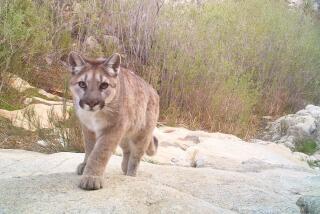Editorial: Save P-45
P-45’s days may be numbered. The 5-year-old mountain lion has managed to cross busy roads safely, has avoided ingesting a lethal dose of rat poison and has successfully claimed his territory from his fellow cougars — all challenges that have stymied other members of the mountain lion population in the Santa Monica Mountains. His fatal mistake, however, was doing what mountain lions naturally do so well: killing and eating prey.
Over the weekend, P-45 apparently broke into two ranches in the hills above Malibu, killing 10 alpacas at one property and a goat and an alpaca at the other. P-45 was identified as the culprit by a tracking device he wears as part of a National Park Service study of the local mountain lion population.
It’s illegal to hunt mountain lions in California thanks to 1990’s Proposition 117, but the initiative included an exception for residents whose livestock is killed by a lion. And on Monday, the owner of the 10 dead alpacas requested and received a special “depredation permit” to hire a hunter to kill P-45. The 10-day permit allows the hunter to cover a 10-mile range around the ranch in search of the lion. Hunters often lure the lion with a deer carcass.
The law ... essentially gives the aggrieved party — the livestock owner — the right to decide whether the lion should live or die.
The ranch owner is within her legal rights to have the lion killed, and she is understandably frustrated. California Department of Fish and Wildlife officials said she had attempted to protect the alpacas from predators by keeping them in a locked area with barbed wire and motion-sensing security lights.
But killing P-45 is not the answer, especially when he is one of the few adult male mountain lions in an isolated population that is at risk of extinction.
Biologists who have been tracking the mountain lions in the Santa Monica Mountains believe P-45 is one of just two breeding-age male lions in the region. If he is killed under a depredation permit and the other dies (getting hit by a car is one of the leading causes of death) there will be a worrisome gap in breeding.
P-45 is of particular significance because biologists think he may have made the treacherous trip across the 101 Freeway to reach the Santa Monica Mountains. If he was indeed born outside the region, then he is bringing valuable genetic diversity to the population. Researchers from UCLA and the National Park Service have predicted lions could disappear from the mountains in 50 years because of inbreeding.
The situation facing the mountain lions in the region is so dire that the state is considering building a $33-million wildlife overpass over the 101 Freeway to allow lions to mingle and mate outside of their families. But it makes no sense to spend millions of dollars building a wildlife overpass for the survival of the mountain lions and yet issue depredation permits to residents so they can kill a lion for behaving like a mountain lion.
Unfortunately for ranchers, biologists say that P-45’s attack on the Malibu ranches was entirely normal behavior for a lion who discovers easy prey, such as domestic animals that are not thoroughly protected. Thorough protection requires a secured enclosure like a barn or a pen surrounded by tall fences. Furthermore, researchers have found that killing one mountain lion — in what advocates for the animals consider “emotional revenge” — doesn’t remove the risk to domestic animals. Younger lions will move into the same territory and continue to attack livestock if the animals are not fully protected.
Of course, people should be allowed to protect themselves and their children if a mountain lion attacks. The law allows individuals to kill a lion if they feel directly threatened or if they catch a lion in the act of killing their livestock. Likewise, the California Department of Fish and Wildlife can kill a lion that is considered a public safety threat.
But the law that allows the issuance of depredation permits essentially gives the aggrieved party — the livestock owner — the right to decide whether the lion should live or die. There is no obligation on the part of the livestock owner to demonstrate that he or she took appropriate precautions to protect the animals. There is no evaluation by a wildlife official as to whether the lion poses a further threat to humans or animals.
Los Angeles residents are lucky to live near wild, open spaces large enough to sustain mountain lions. Surely there is a better way to manage the conflicts that arise when humans and their domestic animals move into areas that have long served as habitat for wildlife.
Follow the Opinion section on Twitter @latimesopinion and Facebook
More to Read
A cure for the common opinion
Get thought-provoking perspectives with our weekly newsletter.
You may occasionally receive promotional content from the Los Angeles Times.






